 |
Authentic Mexican Tacos |
The taco is a very old dish, pre-dating the arrival of the Spanish conquistadors to Central America. There is anthropological evidence that the indigenous people living in the lake region of the Valley of Mexico ate tacos made of tortillas filled with small fish. The first encounter of the conquistadors with the taco was in Coyoacán, a village south of Mexico City. When Hernán Cortés came, it was inhabited by the native Tepanecas, who had their differences with the Aztecs and actually welcomed Cortés, allowing him to use the village as headquarters during his conquest of the Aztec capital of Tenochtitlan (Mexico City). After the Aztec capital was destroyed, Cortés remained in Coyoacan and made it the first capital of New Spain from 1521 to 1523.
In it most basic form, the traditional taco consists of a corn or wheat tortilla, folded around a filling (sliced beef, ground beef, pork, chicken, seafood, vegetables or even cheese), and garnished with salsa, avocado, guacamole, cilantro, tomatoes, onions or lettuce. Mexican tacos come in a great variety, making them the ideal late-night, after-party, street snack.
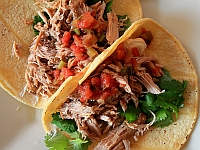 Carnitas taco. |  Barbacoa taco. |
Typical Mexican tacos include:
-
Tacos al Pastor (shepherd style) - thin slices of pork seasoned with adobo seasoning and pineapple, skewered and roasted on a vertical rotisserie, shaved off as the outside is browned, and made into tacos.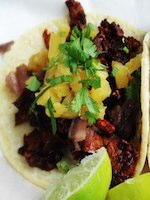
Taco al Pastor. - Tacos de Carnitas - Carnitas means pulled pork, made by braising pork in lard for several hours until very tender and juicy, pulled apart by forks. The taco is served with chopped cilantro (coriander leaves), diced onion, salsa, guacamole. Carnitas originated in the state of Michoacán west of Mexico City.
- Tacos de Carne Asada - Carne asada means "grilled meat", in this case grilled and chopped beef, usually flank steak or skirt steak, marinated in lime juice, salt and seasonings. Carne asada can be served on its own or as part of other dishes: burritos, gorditas, nachos, quesadillas, or tacos. Toppings for Tacos de Carne Asada include cebollita, pico de gallo, cilantro and onions.
- Tacos de Cochinita Pibil - these originate on the Yucatán Peninsula, and are traditionally made from a suckling pig marinated in citrus juice, garlic, and achiote paste, then wrapped in banana leaves and roasted in a traditional Mayan underground pit called a "pib". Pork shoulder or pork butt can be substituted. The texture is similar to pulled pork carnitas, but the taste is very different.
- Tacos de Tinga - Tinga is a stew made with shredded chicken in a delicious
tomato sauce and Chile Chipotle in Adobo sauce. Tinga comes from the state of Puebla, east of Mexico City. Sautéed onions and garlic are mixed with chopped tomatoes, chicken stock, herbs, and spices. Pre-cooked shredded chicken (or sometimes chorizo sausage) is added to the mixture and simmered.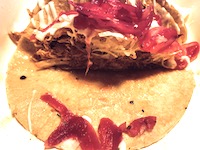
Taco de Tinga. - Chorizo tacos consisting of charbroiled pieces of spicy Mexican chorizo sausage.
- Barbacoa tacos - beef, goat or lamb seasoned with dried chilies and spices, and slow-cooked over an open fire, steamed until tender.
- Tacos Vegetarianos - Roasted slices of opuntia cactus ("prickly pear"), potatoes, onions, and beans, balkan cheese, topped with fresh parsley and jalapeño salsa.
Here are some external links:
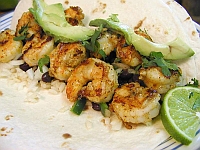 Shrimp taco. |
- Tacos de Camarones - shrimp tacos consisting of sautéed marinated shrimp.
- Tacos de Pescado - fish tacos seasoned fish filet bits crispy fried, topped with red cabbage and spicy tartar sauce
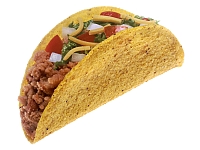 American hard-shell taco. |
- "American tacos" - also called hard-shell tacos made in the United States and Canada, consist of a hard, U-shaped, crispy taco shell made from a corn tortilla, filled with ground beef, lettuce, cheddar cheese & salsa. They were first described in a cookbook called "The good life: New Mexican food" by Fabiola Cabeza de Vaca Gilbert and published in Santa Fe in 1949. Fried U-shaped tortillas are sometimes used in Mexico as well, but it is the ground beef that sets the American taco apart.
- Texas Fajitas - an evolution of the taco,
originating in the Rio Grande Valley region of Texas and northern Mexico.
They are originally cowboy food. During cattle roundups, animals were regularly butchered to feed the ranch hands. The least desirable throwaway parts such as the skirt went to the cowboys. They learned to make the best of the meat by marinading it before grilling it on open fire. This is known in northern Mexican cuisine as "Arracheras" (grilled skirt steak). Fajitas have same roots.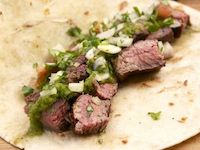
Texas fajitas.The tradition of eating grilled, marinated skirt steak remained confined to southwestern Texas and relatively obscure for decades. Fajitas were first commercialized in late 1960s, in Houston, Austin and San Antonio, but they were still largely unknown outside of Texas until the 1990s. The first fajitas were indeed called "Tacos al Carbon" (char-grilled tacos). The big fajita breakthrough came, of all places, from Germany! In 1982, The Hyatt Regency Austin hotel opened on Barton Springs Road. The hotel restaurant had a chef de cuisine, a German by the name of George (Georg) Weidmann. He promptly recognized the commercial potential of the popular local Tex-Mex dish. He put "sizzling fajitas" on the menu of the Hyatt's La Vista restaurant, and soon sales of that dish made it the most profitable restaurant in the Hyatt chain.
Two things set fajitas and tacos apart: first, fajitas are made (traditionally) from marinated skirt steak, while beef tacos in Mexico can be made from any kind of beef. Second, while tacos are served in twos or threes, already made by the kitchen, fajitas are brought to the table on a large metal platter or skillet, with the condiments and warm tortillas on the side. Each guest makes their own fajitas from the platter in the center of the table.
- 3 lbs rib-eye steak or flank steak, trimmed
- 1/2 cup tequila
- 1/4 cup white vinegar
- 1/4 cup soy sauce
- 4 cloves garlic, minced
- 2 limes, juiced
- 1/2 cup olive oil
- 1 teaspoon salt
- 1 bunch fresh cilantro, chopped
- 1 tsp ground black pepper
- 1 tsp ground white pepper
- 1 tsp garlic powder
- 1 tsp chili powder
- 1 tsp dried oregano
- 1 tsp ground cumin
- 1 tsp paprika
- In a medium bowl, combine tequila, vinegar, soy sauce, garlic, juice of 1 lime, olive oil, salt, black pepper, white pepper, garlic powder, chili powder, oregano, cumin and paprika. Whisk until well blended.
- Lay the flank steak in a large glass baking dish. Pour over the steak in the dish. Turn over once to coat both sides. Cover with plastic wrap, and marinate overnight.
- In a small bowl, stir together 1 chopped white onion, cilantro, and the juice of 1 lime. Set aside to use as a relish for the tacos.
- Prepare charcoal grill, or preheat the oven to 450 deg F (230 deg C).
- Grill the steak 5-10 minutes per side. Remove from grill and slice diagonally across the grain into thin slices.
- Warm the tortillas in a dry skillet for about a minute on each side to make them pliable. Tortillas may also be warmed in a microwave oven. Arrange two or three tortillas on a plate, and lay a generous amount of beef over them. Top with a sprinkle of the onion relish and a large spoonful of the pureed salsa. Add as much cheese as you like. Garnish with lime wedges, and serve.
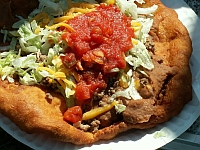 Navajo taco made with frybread. |
In 1988, the Taquería Corona opened in New Orleans. It was a small-greasy spoon on Magazine Street, opened by restaurateur Roberto Méndez, a San Salvador native who came to the United States as a well-trained chef and manager. He introduced New Orleans to inexpensive,
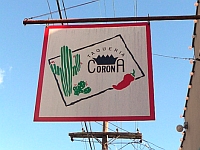 Taquería Corona in New Orleans. |
Méndez's secret is using the best and freshes ingredients, hand-cutting his produce, and using vegetable oils rather than the traditional lard, as well as trimmed lean meats. His menu always had diversity, expanding the image of tacos as beign made only with ground beef, tomato, cheese and lettuce.
Taquería Corona has grown since then. It has 3 restaurants in Uptown New Orleans, Metairie, and Harahan.
Here is a version of the beef tacos just like those served in the Corona.
Ingredients:
Preparation:
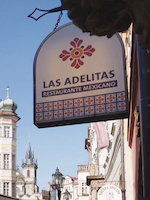 Las Adelitas restaurant in Prague. |
Today, Las Adelitas has four full-service restaurants around Prague, and two taquerias.
back to Radim and Lisa's Well-Travelled Cookbook | email us
Originally written on March 30, 2003; updated on June 1, 2014 & November 17, 2021
